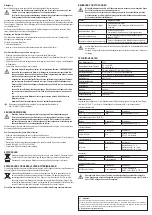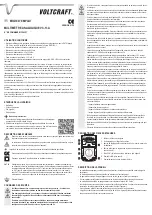
Legal notice
This is a publication by Conrad Electronic SE, Klaus-Conrad-Str. 1, D-92240 Hirschau (www.conrad.com).
All rights including translation reserved. Reproduction by any method, e.g. photocopy, microfilming, or the capture in electronic data
processing systems require the prior written approval by the editor. Reprinting, also in part, is prohibited. This publication represent
the technical status at the time of printing.
© Copyright 2016 by Conrad Electronic SE.
G
TROUBLESHOOTING
In purchasing the multimeter, you have acquired a product which has been designed to
the state of the art and is operationally reliable.
Nevertheless, problems or faults may occur. Therefore, we would like to describe here
how you can solve any problems. Always observe the safety instructions!
Error
Possible cause
No resistance measurement possible.
Is the battery dead?
Check the state of the battery and, if necessary, the fuse.
No measurement possible.
Is the fuse defective?
Check the fuse (fuse replacement).
No change in measured value.
Is the right measuring range and measuring mode selected
(AC/DC)?
Incorrect measurement values are
displayed.
Did you zero the display or carry out a 0-Ohm calibration for
resistance measurement before beginning the measure-
ment?
Repairs other than described above are to be carried out exclusively by an authorised special-
ist.
If you have questions concerning the use of the meter, please contact our technical support
team.
TECHNICAL DATA
Max. measuring voltage
300 V
Input resistance for V range
DC: approx.10 kΩ/V
AC: approx. 4.5 kΩ/V
Power supply
1 Mignon battery 1.5 V (AA, UM3, LR6, etc.)
Operating conditions
0 °C to +40 °C, <75% relative humidity, not condensing
Storage temperature
-10 °C to +50 °C, <80% relative humidity, not condensing
Measurement category
CAT III 300 V
Pollution degree
2
Operating altitude
max. 2000 m above sea level
Protection class
2
Weight
approx. 120 g
Dimensions (L x W x H)
116 x 68 x 34 mm
Length of the measuring cable
approx. 650 mm
Measurement tolerances
Specification of the precision in ± (% of the scale value). The precision is valid for one year at a tempera-
ture of +23 °C ± 2 °C, and at a relative humidity of less than 60%, non-condensing.
Direct voltage range
Range
Precision
Note
2,5 V / 10 V / 50 V / 250 V / 300 V
±4%
Internal resistance 10 kΩ / V
Alternating voltage range (50/60 Hz)
Range
Precision
Note
10 V / 50 V / 250 V / 300 V
±5%
Internal resistance 4.5 kΩ / V
Direct current range
Range
Precision
Note
10 mA / 250 mA
±4%
F500mA H 500V fast-blowing
6.3 x 32 mm, ceramic
Resistance range
Range
Precision
Note
X10 / x1k
±4%
Measurement voltage: -1.5 V
Measurement current (x10): approx. 15 mA
Measurement current (x1k): approx. 0.15 mA
Battery test
Range
Accuracy
Note
1.5 V / 9 V
not specified
Attenuation measurement dBm
Range
Accuracy
Note
-20 dBm to +22 dBm
not specified
10 V/AC measurement range
0 dB = 1 mW / 600 Ω (0.775 V)
Do not exceed the maximum permitted input values under any circumstances. Never
touch circuits or parts of circuits when they may contain voltages greater than 33 V/
ACrms or 70 V/DC! Risk of fatal injury!
Cleaning
Always observe the following safety instructions before cleaning the device:
Live components may be exposed if the covers are opened or parts are removed, unless
this can be done manually without tools.
Before cleaning or repairing of the device, all the cables have to be detached and the
device must be turned off.
Do not use any scouring cleansers, petrol, alcohol or the like to clean the product. These could corrode the
surface of the measuring instrument. Furthermore, the fumes are explosive and hazardous to your health.
Moreover, you should not use sharp-edged tools, screwdrivers, metal brushes or similar implements for
cleaning.
To clean the device, the display or the measurement lines, use a clean, dry, lint-free anti-static cleaning
cloth.
Inserting/changing the batteries
To use the measuring instrument in the resistance range, a Mignon (AA) type battery, included in the
package, is required.
Insert a new battery:
• when using for the first time,
• when a 0-Ohm adjustment in the resistance measuring range can no longer be performed.
To insert/replace the battery, proceed as follows:
• Remove all the measuring leads from the device and turn the multimeter off.
• Loosen the screw on the rear of the battery compartment and carefully remove the cover (7) of the bat-
tery compartment by pulling it backwards.
• Now place a new battery into the battery compartment, observing the correct polarity. Look for the polar-
ity signs in the battery tray.
• Now, close the cover carefully again.
Never operate the meter when it is open. ! RISK OF FATAL INJURY!
Do not leave flat batteries in the device. Even batteries that are leak-proof can corrode
and thus release chemicals that could be detrimental to your health or damage the
device.
Leaking or damaged batteries might cause severe burns if they come into contact with
the skin. Therefore, use suitable protective gloves.
Remove the battery if the device is not to be used for a long time, to prevent leaking.
Do not leave batteries lying around carelessly. They could be swallowed by children or
pets. If swallowed, consult a doctor immediately.
Make sure that the batteries are not short-circuited. Do not throw batteries into a fire.
Batteries may not be recharged. There is risk of explosion.
You can order suitable alkaline batteries by stating the following order no.:
Order no. 652501 (please order 1x).
CHANGING THE FUSE
Always adhere carefully to the safety instructions when replacing the fuse!
Make sure that only fuses of the type stated and of the rated current specified are used
as a replacement. The use of incorrect or repaired fuses or a bypassing of the fuse
holder is not permitted and can lead to a fire or to an arc explosion.
The measuring input is protected against overload. If you can no longer carry out measurements, you have
to replace the internal high-performance fuse.
Proceed as follows to change the fuse:
• Remove all measuring leads and turn the multimeter off.
• Loosen the screw on the rear of the housing and carefully remove the cover (7) of the battery compart-
ment by pulling it backwards.
• Replace the high-performance fuse with a new fuse of the same type and current strength.
• Ceramic F500mA H 500 V fast blowing 6.3 x 32 mm.
• Now, close the cover carefully again.
DISPOSAL
Electronic products are recyclable material and do not belong in the household waste. Dispose
of an unserviceable product in accordance with the relevant statutory regulations.
Remove the inserted battery and dispose of them separately from the product.
DISPOSAL OF USED BATTERIES/RECHARGEABLE BATTERIES!
As the end user, you are required by law (Battery Regulation) to return used batteries. Do not dispose of
used batteries in the household waste!
Batteries/rechargeable batteries containing harmful substances are marked with the following
symbols, they point out that they are not allowed to be disposed of in the household waste. The
symbols of the relevant heavy metals are: Cd = cadmium, Hg = mercury, Pb = lead (the marking
can be seen on the battery, e.g. underneath the refuse bin symbol shown on the left). You can
return your used batteries/rechargeable batteries free of charge at the official collection points of
your community, in our stores, or at places where batteries or rechargeable batteries are sold!
You thereby fulfil your statutory obligations and contribute to the protection of the environment!












